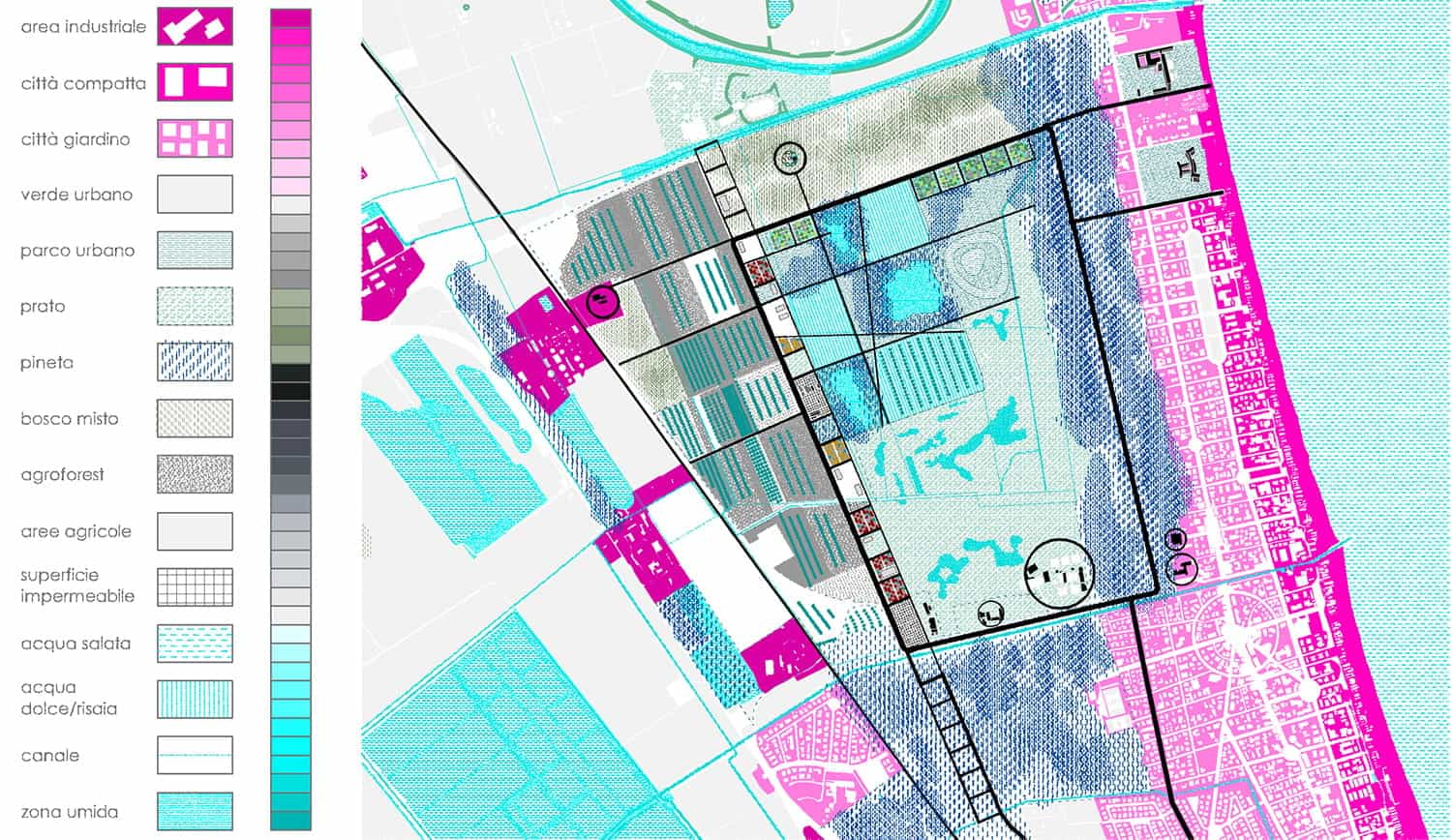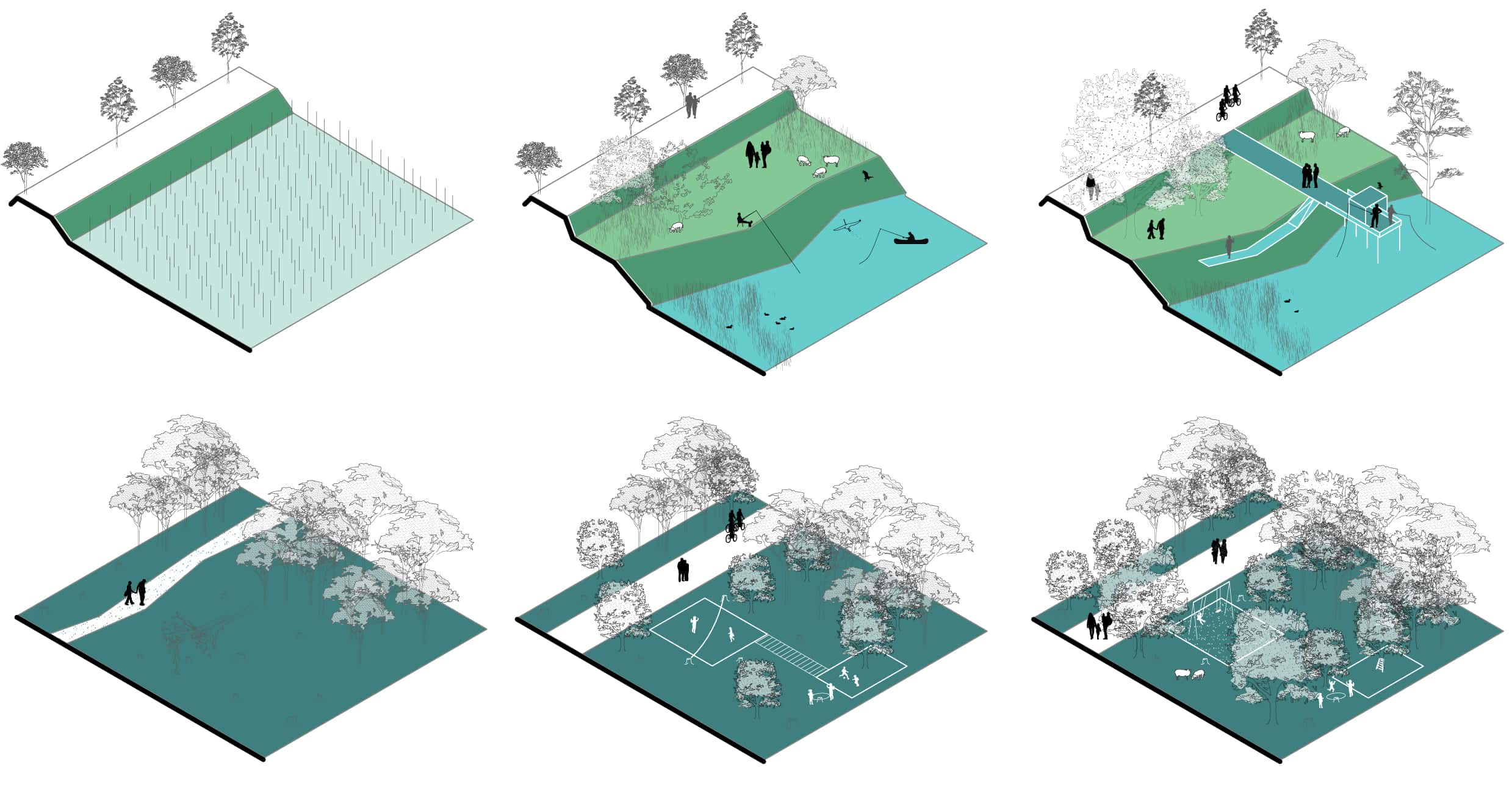



New Public Park in Cervia “the Bassona area”
location:
Cervia
ITALY
client:
City of Cervia
year:
2020
program:
landscape
status:
competition
Cervia
ITALY
client:
City of Cervia
year:
2020
program:
landscape
status:
competition
THE CLIMATIC “LOOP”-A connected, equipped and productive park in a resilient city
The “loop” outlines the park’s shape and a new cycle of urban development for Cervia. After Cervia Vecchia evolved into Cervia Nuova in the 17th century and the construction of Milano Marittima, a garden city, in the 20th century, the park project in the Bassona area is a new idea for a "resilient city" with a park active year-round in city life and intended to increase visitors with " green tourism.”
ONE PARK, FOUR COMPONENTS
• a climatic park: The "loop" connects all the climate varieties of Cervia and adapts the city to climate change with plants ranging from a pine forest to deciduous trees.
• a connected park: For easy residential and tourist access, the main 6 km "loop" extends throughout all of Cervia, welcoming new forms of mobility like electric bikes, while remaining accessible to farm vehicles.
• an equipped park: The loop connects existing facilities such as the convention center, the butterfly house, the golf club and the stadium with future ones: new public services and private activities, sport zones, game areas for children, something for everyone. It permits the local rural heritage to be revitalized.
• a productive park: The park-loop has a productive scope, given the activities geared towards revitalizing existing buildings and expanding the agriculture integral to the park.
THE TIMES OF A PARK: A SHORT-TERM OPENING OF LOOP AND A "FOUR SEASONS" PARK
Such a large area needs consideration as to when the project will be put to use. Proposing the loop allows the park to have clear boundaries in the short term. The park-loop offers the possibility for varied human impact in it, depending on the season. The park is accessible year round, offers more space for human use during the summer and more ecological activity in other seasons.
A MOSAIC OF LIVING LANDSCAPES AND ECOLOGICAL ENVIRONMENTS
• In the center of the park, the project proposes a progressive evolution of the existing rice fields. Part could be turned into wetlands with a hydraulic system and modifying the topography, thus obtaining deeper, more humid areas year-round.
• The western part along the loop: compatible economic activities or public services are developed using existing unused buildings. Agricultural production is diversified, with pastoral activities, orchards and greenhouse yields destined for local consumption.
• The forest plantations: the pine forest, currently a fragile, single tree species, will be progressively enriched with many broad-leaf and holm oak species, adaptable to climate change. Areas devastated by the recent storm will be renewed as a wooded heritage, including a dominantly deciduous species as the choice for new tree stands. Planting young trees will strengthen the root system and resistance to extreme weather.
• The agricultural areas: Introducing trees is compatible with continuing crop production and has numerous advantages. This phase could be carried out with the cooperation of farmers.
The “loop” outlines the park’s shape and a new cycle of urban development for Cervia. After Cervia Vecchia evolved into Cervia Nuova in the 17th century and the construction of Milano Marittima, a garden city, in the 20th century, the park project in the Bassona area is a new idea for a "resilient city" with a park active year-round in city life and intended to increase visitors with " green tourism.”
ONE PARK, FOUR COMPONENTS
• a climatic park: The "loop" connects all the climate varieties of Cervia and adapts the city to climate change with plants ranging from a pine forest to deciduous trees.
• a connected park: For easy residential and tourist access, the main 6 km "loop" extends throughout all of Cervia, welcoming new forms of mobility like electric bikes, while remaining accessible to farm vehicles.
• an equipped park: The loop connects existing facilities such as the convention center, the butterfly house, the golf club and the stadium with future ones: new public services and private activities, sport zones, game areas for children, something for everyone. It permits the local rural heritage to be revitalized.
• a productive park: The park-loop has a productive scope, given the activities geared towards revitalizing existing buildings and expanding the agriculture integral to the park.
THE TIMES OF A PARK: A SHORT-TERM OPENING OF LOOP AND A "FOUR SEASONS" PARK
Such a large area needs consideration as to when the project will be put to use. Proposing the loop allows the park to have clear boundaries in the short term. The park-loop offers the possibility for varied human impact in it, depending on the season. The park is accessible year round, offers more space for human use during the summer and more ecological activity in other seasons.
A MOSAIC OF LIVING LANDSCAPES AND ECOLOGICAL ENVIRONMENTS
• In the center of the park, the project proposes a progressive evolution of the existing rice fields. Part could be turned into wetlands with a hydraulic system and modifying the topography, thus obtaining deeper, more humid areas year-round.
• The western part along the loop: compatible economic activities or public services are developed using existing unused buildings. Agricultural production is diversified, with pastoral activities, orchards and greenhouse yields destined for local consumption.
• The forest plantations: the pine forest, currently a fragile, single tree species, will be progressively enriched with many broad-leaf and holm oak species, adaptable to climate change. Areas devastated by the recent storm will be renewed as a wooded heritage, including a dominantly deciduous species as the choice for new tree stands. Planting young trees will strengthen the root system and resistance to extreme weather.
• The agricultural areas: Introducing trees is compatible with continuing crop production and has numerous advantages. This phase could be carried out with the cooperation of farmers.








